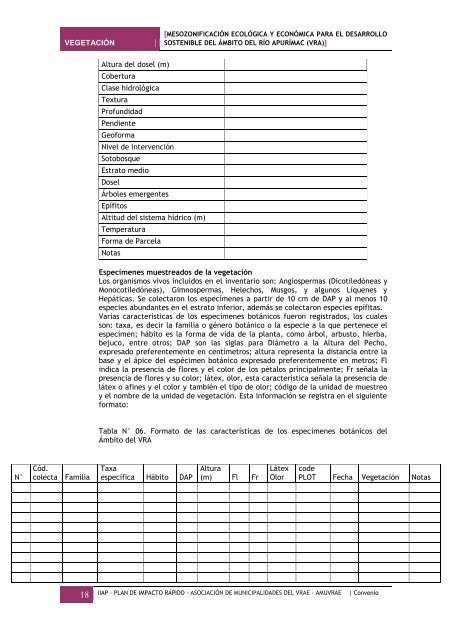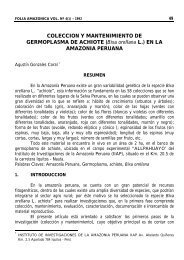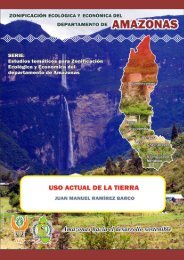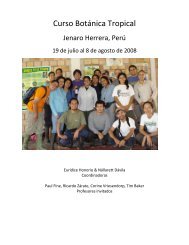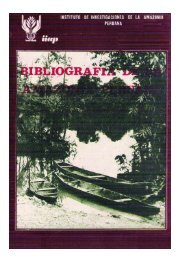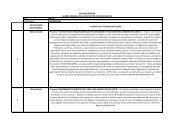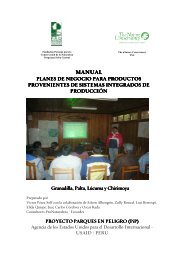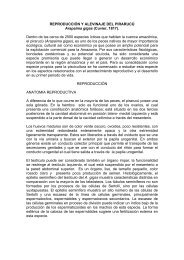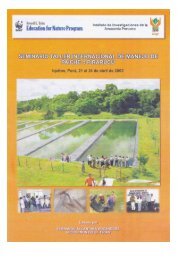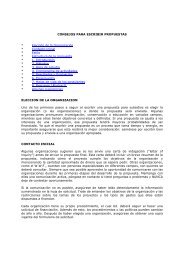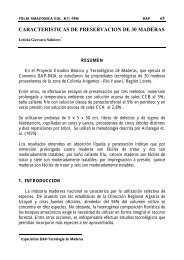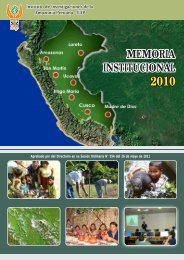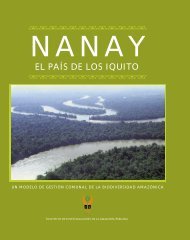Descargar - Instituto de Investigaciones de la Amazonía Peruana
Descargar - Instituto de Investigaciones de la Amazonía Peruana
Descargar - Instituto de Investigaciones de la Amazonía Peruana
You also want an ePaper? Increase the reach of your titles
YUMPU automatically turns print PDFs into web optimized ePapers that Google loves.
N°<br />
VEGETACIÓN<br />
Cód.<br />
colecta Familia<br />
Altura <strong>de</strong>l dosel (m)<br />
Cobertura<br />
C<strong>la</strong>se hidrológica<br />
Textura<br />
Profundidad<br />
Pendiente<br />
Geoforma<br />
Nivel <strong>de</strong> intervención<br />
Sotobosque<br />
Estrato medio<br />
Dosel<br />
Árboles emergentes<br />
Epífitos<br />
Altitud <strong>de</strong>l sistema hídrico (m)<br />
Temperatura<br />
Forma <strong>de</strong> Parce<strong>la</strong><br />
Notas<br />
[MESOZONIFICACIÓN ECOLÓGICA Y ECONÓMICA PARA EL DESARROLLO<br />
SOSTENIBLE DEL ÁMBITO DEL RÍO APURÍMAC (VRA)]<br />
Especímenes muestreados <strong>de</strong> <strong>la</strong> vegetación<br />
Los organismos vivos incluidos en el inventario son: Angiospermas (Dicotiledóneas y<br />
Monocotiledóneas), Gimnospermas, Helechos, Musgos, y algunos Líquenes y<br />
Hepáticas. Se colectaron los especímenes a partir <strong>de</strong> 10 cm <strong>de</strong> DAP y al menos 10<br />
especies abundantes en el estrato inferior, a<strong>de</strong>más se colectaron especies epífitas.<br />
Varias características <strong>de</strong> los especímenes botánicos fueron registrados, los cuales<br />
son: taxa, es <strong>de</strong>cir <strong>la</strong> familia o género botánico o <strong>la</strong> especie a <strong>la</strong> que pertenece el<br />
especímen; hábito es <strong>la</strong> forma <strong>de</strong> vida <strong>de</strong> <strong>la</strong> p<strong>la</strong>nta, como árbol, arbusto, hierba,<br />
bejuco, entre otros; DAP son <strong>la</strong>s sig<strong>la</strong>s para Diámetro a <strong>la</strong> Altura <strong>de</strong>l Pecho,<br />
expresado preferentemente en centímetros; altura representa <strong>la</strong> distancia entre <strong>la</strong><br />
base y el ápice <strong>de</strong>l espécimen botánico expresado preferentemente en metros; Fl<br />
indica <strong>la</strong> presencia <strong>de</strong> flores y el color <strong>de</strong> los pétalos principalmente; Fr seña<strong>la</strong> <strong>la</strong><br />
presencia <strong>de</strong> flores y su color; látex, olor, esta característica seña<strong>la</strong> <strong>la</strong> presencia <strong>de</strong><br />
látex o afines y el color y también el tipo <strong>de</strong> olor; código <strong>de</strong> <strong>la</strong> unidad <strong>de</strong> muestreo<br />
y el nombre <strong>de</strong> <strong>la</strong> unidad <strong>de</strong> vegetación. Esta información se registra en el siguiente<br />
formato:<br />
Tab<strong>la</strong> N° 06. Formato <strong>de</strong> <strong>la</strong>s características <strong>de</strong> los especímenes botánicos <strong>de</strong>l<br />
Ámbito <strong>de</strong>l VRA<br />
Taxa<br />
específica Hábito DAP<br />
Altura<br />
(m) Fl Fr<br />
Látex<br />
Olor<br />
co<strong>de</strong><br />
PLOT Fecha Vegetación Notas<br />
18 IIAP - PLAN DE IMPACTO RÁPIDO - ASOCIACIÓN DE MUNICIPALIDADES DEL VRAE - AMUVRAE | Convenio


